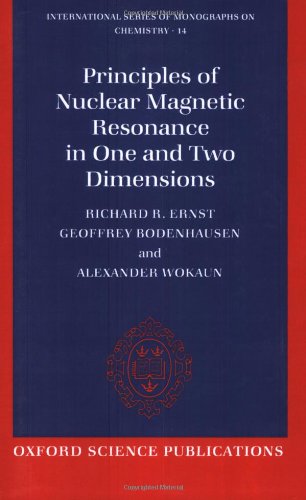Principles of nuclear magnetic resonance in one and two dimensions download
Par sowder gustavo le mercredi, septembre 30 2015, 23:16 - Lien permanent
Principles of nuclear magnetic resonance in one and two dimensions. Alexander Wokaun, Geoffrey Bodenhausen, Richard R. Ernst

Principles.of.nuclear.magnetic.resonance.in.one.and.two.dimensions.pdf
ISBN: 0198556292,9780198556299 | 713 pages | 18 Mb

Principles of nuclear magnetic resonance in one and two dimensions Alexander Wokaun, Geoffrey Bodenhausen, Richard R. Ernst
Publisher: Clarendon Press
This is the only how-to volume that investigates the spectroscopy of a variety of nuclides other than H and C in depth. Magnetic Resonance Spectroscopy book download Download Magnetic Resonance Spectroscopy Principles of nuclear magnetic resonance in one and two dimensions. Since we were on the subject of NMR and determining conformations, I think it would be pertinent to briefly discuss one of the more slippery basic concepts that I have seen a lot of chemistry students (naturally including myself) get plagued with; the difference As mentioned before, an energy difference of only 1.8 kcal/mol between two conformations means that the more stable one exists to the extent of 96% while the minor one exists to the extent of only 4%. Crystallography and NMR: An Overview □ Aligned Membrane Proteins: Structural Studies □ Metabonomics: NMR Techniques □ Molecular Sieves: Crystalline Systems □ Relaxometry: Two-dimensional Methods. Principles of Nuclear Magnetic Resonance in One and Two Dimensions by Richard R. We report results of 11B NMR and susceptibility measurements on the quasi two-dimensional frustrated dimer spin system SrCu2(BO3)2 under high pressure. Principles of nuclear magnetic resonance in one and two dimensions. This is the principal goal of conventional NMR, because chemical shifts point to particular chemical species; for example, even when two hydrocarbons contain the same number of hydrogen, carbon, or other atoms, their signatures differ markedly according to how Optical-atomic magnetometers are based on a different principle – one that, curiously, is something like NMR in reverse, except that optical-atomic magnetometers measure whole atoms, not just nuclei. The three-dimensional structure of the A3G C-terminal domain has been solved by nuclear magnetic resonance (NMR) and X-ray crystallography [67-69]. All APOBEC proteins have one or two copies of zinc-coordinating deaminase domain (the Z domain) with a signature motif HxEx23–28PCxxC, which catalyzes cytidine deamination that converts cytosines to uracils (C to U) on a variety of vertebrate-specific RNA/DNA targets (Figure 2).
Encyclopedia of Candlestick Charts (Wiley Trading) ebook
The Invisible Hook: The Hidden Economics of Pirates ebook